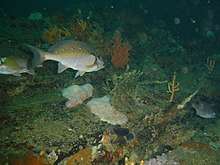| Chirodactylus brachydactylus | |
|---|---|

| |
| Scientific classification | |
| Domain: | Eukaryota |
| Kingdom: | Animalia |
| Phylum: | Chordata |
| Class: | Actinopterygii |
| Order: | Centrarchiformes |
| Family: | Cheilodactylidae |
| Genus: | Chirodactylus |
| Species: | C. brachydactylus |
| Binomial name | |
| Chirodactylus brachydactylus (Cuvier, 1830) | |

Chirodactylus brachydactylus, the twotone fingerfin, is a species of marine fish in the fingerfin (morwongs) family (family Cheilodactylidae) of order Perciformes. It is native to the coast of southern Africa.
Distribution
Along the coast of southern Africa from Walvis Bay to Maputo. Subtropical, between 23°S and 36°S in eastern Atlantic and western Indian oceans.
Description
Body colour basically brown, paler on ventral side, with a brighter white area below the eyes in the front part of the body, and a row of five white spots along the lateral line. Juveniles are silvery with orange anal and paired fins. Colour changes to adult colouration from about 5 cm. The fish has fleshy lips around a small mouth. Length up to 40 cm, weight up to 3 kg. Matures at 25 cm, and spawns in summer.
Habitat and ecology
Rocky reefs and sandy areas near reefs at depths to 240 m. Juveniles may be found in rock pools. C. brachydactylus is a small-benthic-invertebrate predator, There is some dietary overlap between the species assembages of the reef predators, in which this fish occurs, but each appears to have a dietary niche which reduces interspecific competition for food. Its diet includes crabs, anphipods, bivalves and other invertebrates. C. brachydactylis is preyed upon by large reef predators, including the santer seabream, (Cheimerius nufar), red steenbras (Petrus rupestris), scotsman (Polysteganus praeorbitalis), and yellowbelly rockcod (Epinephelus marginatus).
Importance to humans
Does not often take a hook, but relatively easily caught spearfishing.
Conservation status
Not evaluated.
References
- ^ Heemstra, Phil; Heemstra, Elaine (2004). Coastal fishes of Southern Africa. Grahamstown: NISC and SAIAB. ISBN 1-920033--01-7.
- Smith, J.L.B. (1977). Smith's sea fishes. Cape Town: Valiant publishers. ISBN 0-86884-029-7.
- ^ Froese, Rainer; Pauly, Daniel (eds.). "Chirodactylus brachydactylus". FishBase. August 2023 version.
- ^ Jones, Georgina (2008). A field guide to the marine animals of the Cape Peninsula. Cape Town: SURG. ISBN 978-0-620-41639-9.
- Branch, G.M.; Branch, M.L.; Griffiths, C.L.; Beckley, L.E. (2010). Two Oceans: a guide to the marine life of southern Africa (2nd ed.). Cape Town: Struik Nature. ISBN 978-1-77007-772-0.
- Lechanteur, Y.A.R.G.; Griffiths, C.L. (2003). "Diets of common suprabenthic reef fish in False Bay, South Africa". African Zoology. 38: 213–227.
- Smale, M.J. (1986). "The feeding biology of four predatory reef fishes off the south-eastern Cape coast, South Africa". S.-Afr. Tydskr. Dierk. 21 (2).
| Taxon identifiers | |
|---|---|
| Chirodactylus brachydactylus | |